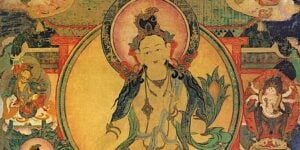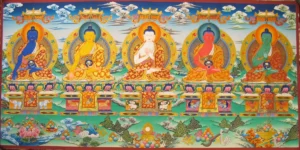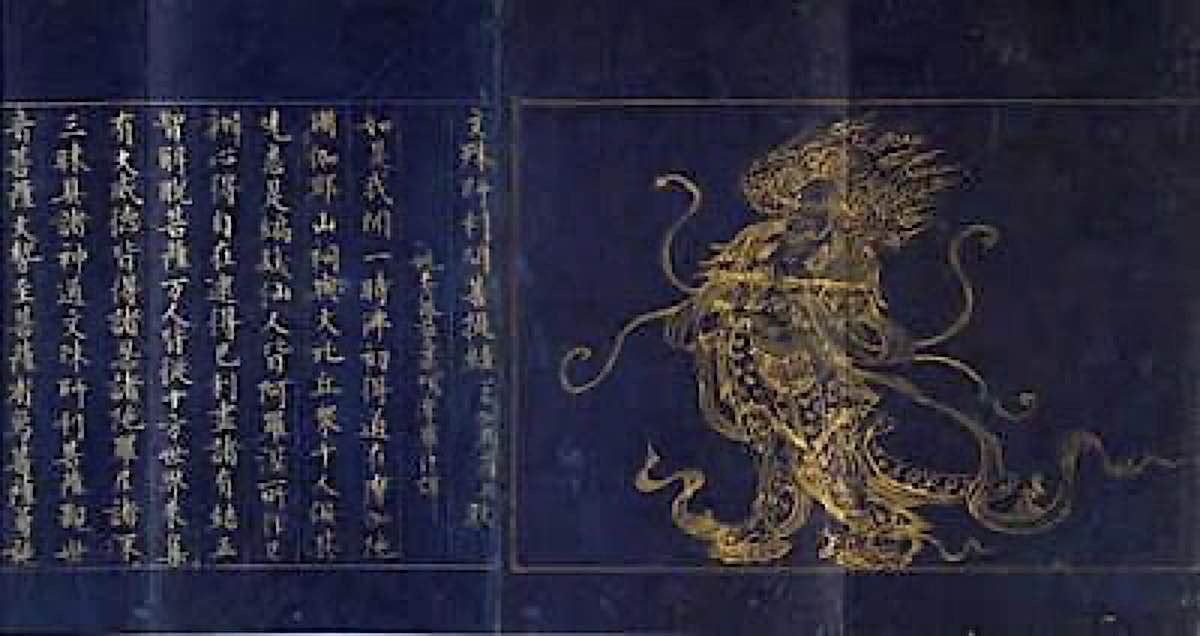Video: Heart Sutra Commentary by H.E. Zasep Tulku Rinpoche Part 1: Teachings on Emptiness and the Skandas of Form and Feeling
Part 1 of an important commentary on Heart Sutra, and especially on the true nature of Shunyata (Emptiness) — a concept often misinterpreted. Heart Sutra is the most important sutra teaching on Shyunyata. In part 1 of his 2-part teaching on the Heart Sutra, H.E. Zasep Tulku Rinpoche goes into detail on the first two Skandas (Form and Feeling):
Form is Emptiness; Emptiness is Form. Feelings are Emptiness; Emptiness is Feeling.
He explains the profound meaning — and why it is comforting to Buddhists. Rinpoche starts by explaining dependent-arising and how we do not exist independently. His discussion on Emptiness of Feeling is especially helpful for people who are going through difficult times. Watch for Part 2 of this series, where Rinpoche discusses the remaining three Skandas and helps us understanding the profound concepts of Shunyata.
Full video of part 1 of the commentary and teaching on the Heart Sutra plays below:
H.E. Zasep Tulku Rinpoche brings clarity for all levels of student on this difficult concept and delivers a wonderful commentary on this important sutra. The Heart Sutra or Essence Sutra presents the meaning of Shunyata in a very concise and penetrating way. It is the briefest of all the Perfection of Wisdom Sutras. The full-length Sutra of the Perfection of Wisdom has 100,000 verses. Then there is the middle length Perfection of Wisdom Sutra, which has 20,000 verses, and then a shorter version of 8,000 verses.
Full Biography of H.E. Zasep Rinpoche below Heart Sutra.
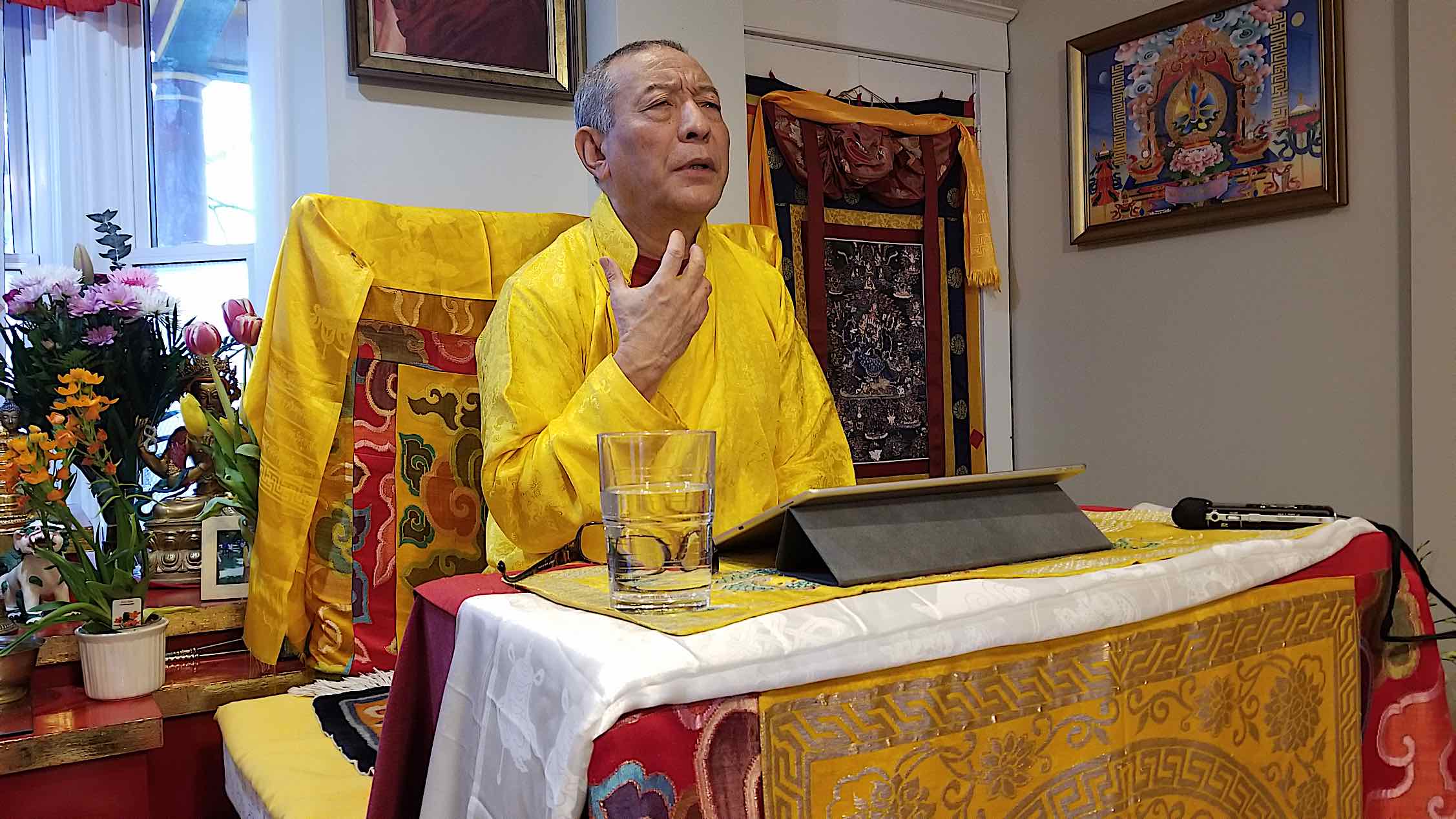
Transcript of the Commentary on Heart Sutra part 1 from H.E. Zasep Rinpoche
The subject of the teaching today is a commentary on Heart Sutra. Heart Sutra is the essence of Prajnaparamita sutra. The reason why it is called heart, because it is the essence; also it’s like a physical heart of human body, it’s one of the most important organs of the human body. Like that, this is one of the most important teachings.
It starts with, “Thus have I heard.” So after Buddha entered Nirvana, his disciples, great disciples, Mahākāsyapa, Shariputra, Subhuti, Ananda, and so forth gathered together with the thousands other monks and practitioners and had a great council, and then they decided to record the teachings.
So one of the great disciples, Shariputra said, “Thus I have heard”. So they recorded the teachings in their mind, in their deep, profound samadhi and unforgetting samadhi. So then they start talking, and then wrote down on palm leaves, this is how it started.
The Heart Sutra was taught at Vulture’s Peak Mountain in Rajagriha in central India, Magadha Kingdom. And there is a mountain, and these rocks have shape like vultures, like they’re gathering. That’s why we call the Vulture’s Peak Mountain.
There’s another story that is before or during Buddha’s, during the teaching, the many enlightened ones and yogis and arhat who could fly like a bird in the gathering — and they flew like a bird, like vultures, and that’s why it’s called Vulture’s Peak Mountain, and so many of them gathered like flocks of birds. And so these are different ways of interpreting the word, “Vulture’s Peak Mountain.”
So many Bodhisattvas gathered and many arhats gathered, and at that time Buddha himself entered into deep, profound samadhi. And it’s called profound illuminations… entering profound samadhi.
The Heart Sutra is actually not a spoken word of the Buddha (it is the spoken word of Avalokiteshvara), and this sutra is endorsed by the Buddha and approved by the Buddha and blessed by the Buddha himself. And what happened here is that Buddha himself entered into this deep samadhi, then Bodhisattva, Avalokiteśvara, and Shariputra, who were sitting close to Buddha, perhaps on each side of the Buddha, and then there was so many listeners and Bodhisattvas and arhats, monks, and so forth.
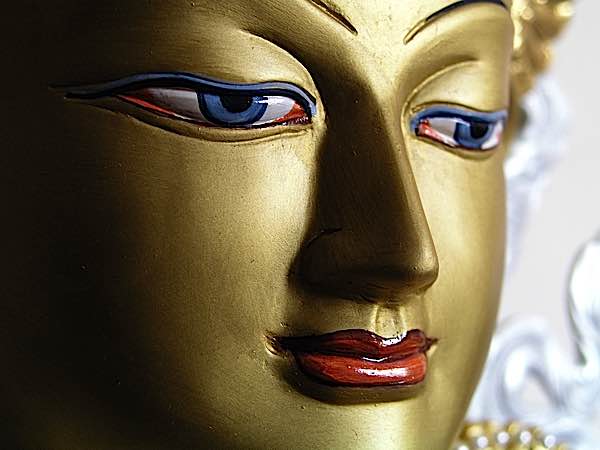
And at that time, Avalokiteshvara himself was looking at that deep meaning, true meaning of Prajnaparamita. And then Shariputra made a request to Avalokiteshvara, and Avalokiteshvara started teaching. Avalokiteshvara said,
“Five skandas, the nature of the five skandas are empty of true existence, or empty of inherent existence.”
And by the blessing of the Buddha, Shariputra was encouraged … to ask questions to Avalokiteshvara and he asked questions on the Perfection of Wisdom, and at that time then Avalokiteshvara said to Shariputra, “Those who wish to listen, who wish to practice and meditate on Prajnaparmita, and those sons or daughters or anyone who wish to listen and meditate and practice Prajnaparmita, then they should look deeply and concentrate and try to understand meaning of Prajnaparmita.”
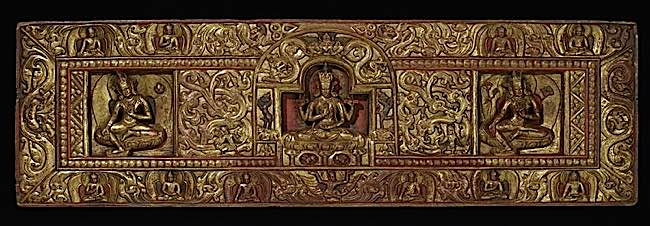
Prajnaparmita means “Perfection of Wisdom” or transcendental wisdom… So then Avalokiteshvara said,
“The five skandas are empty of inherent existence. The nature of five skandas are empty of inherent existence, and form is emptiness; and emptiness is also form. Likewise, feeling is emptiness; and emptiness is also feeling. Likewise, perception is emptiness; emptiness is also perception. And likewise mental formation is emptiness; emptiness is also mental formation. Likewise, consciousness is emptiness; emptiness is also consciousness.”
So all five skandas are emptiness, or empty of inherent existence. So what it means is that each of five skandas — they do not exist inherently, and they are independent. So when we hear, when we talk about form is emptiness, we’re not talking about the form doesn’t exist, there is no form, and we’re not negating the form or refuting the form. How could you do that? Not possible and not necessary.
And form is emptiness means the true meaning, deep meaning, at an ultimate level, the form doesn’t exist all by itself, and independently.
So if you look at, or when you look at, when you meditate, if you look at the body from meditate … If you do analytical meditation and look at from the top of your head to the bottom of your feet, go slowly, do what we call “sweeping meditation,” it’s like you’re sweeping the floor with a broom from one end of the room to the other end of the room, and that’s sweeping, right, sweeping the floor. Like that, we can do sweeping meditation of the body. Our modern term, today’s term of technology, you could say, “scanning the body.” So you can do that, and you look through the body, outside the body, and outside this body, or inside the body, doesn’t exist independently, inherently.

This body is high maintenance, as we all know. You have to eat good, you have to drink water, you need to sleep, you have to do exercise, and you need go for a walk, drink lots of water, and so on and so forth. And then you try to do some practice meditation, a mindfulness calm abiding meditation, you do mantras and so forth to release your stress and tension, mental health and happiness and so forth.
This body is high maintenance, so this body need a lot of things, and this body is dependent on so many things. And ever since the body is started, when the body was very small, and inside mother’s womb, and as you grow, as a baby, and then you have more maintenance. And as you get bigger and bigger, more food and more consumptions, require so many things.
So this body is interdependent, and what we call, “dependent-arising.” But at the same time, this body is empty of inherent existence. So the emptiness and dependent-arising, they are co-existent, like one side of the door is the entrance, the other side of the door is the exit. So it’s one door, without entrance there is no exit; without exit, there is no entrance.
Dependent-arising and Emptiness are One
Likewise, dependent-arising and emptiness are one. For example, when we say dependent-arising, it naturally means there is no independent, right? Nothing is independent exist. So that’s the same as when you say emptiness, emptiness of inherent existing, or independently existing. So this body doesn’t exist independently, it cannot live, support, and sustain independent.
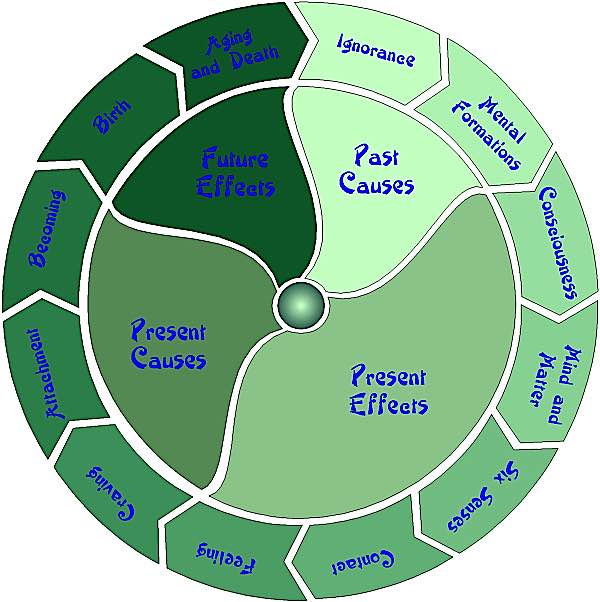
So therefore, we are saying here form is emptiness, the Avalokiteshvara said, “Form is emptiness.” And when you look at the form, you don’t find the independent existence, any part of form, or any kind of form, therefore the form is emptiness.
The emptiness of the form is a form because the emptiness of the form is based on form. Without the form, there is no emptiness of form. So emptiness of form is based on form, for that reason we say the form is emptiness; emptiness is also form. The emptiness of form is form.
Lama Tsonkhapa commentary

So this is how we have to understand dependent-arising, emptiness are co-existent. This is what Lama Tsongkhapa advised or said in his commentaries, and one should not separate dependent-arising and emptiness
As long as you are separating, totally separating dependent-arising and the emptiness, then you don’t understand emptiness, because they are one. And this is the middle way, what we call Madhyamaka, so form is emptiness.
Why do we meditate on Emptiness?
Now, so why do we meditate on the emptiness of form, and why do we have to try to understand emptiness of form? Because this body, as I said, it has lots of many parts, and I mentioned that, right?
So also, we have attachment to this body, and we have aversion to this body, we have some form of aggression towards this body, or somebody else’s body, and lots of mental defilements: ignorance, attachment, and anger, and so on and so on, lots of mental defilements arising.
Craving food, alcohol, drugs, “I want, I want”
And due to this body, and for example, craving for food and drink and this and that, alcohol, cigarette, drugs, all these cravings, because your body says, “I want this, I want this, I need this.” Not just body, but mind too. It is all associated, all five skandas go together.

So this is why we meditate on emptiness of form, [inaudible 00:16:37], so when you meditate on form, emptiness of form, then you begin to see the nature of this body is emptiness, right, and Shunyata, and doesn’t have inherently good or bad, and this and that.
And the meditation on emptiness of the form is remedy, and is antidote for defilements and attachment and craving, desire, and so forth that has to do with this body and arising from this body, coming and going and so forth.
For example, we have neurosis, we have attachment, and because of this body,
“Oh, I’m not beautiful anymore, I’m getting old, my body is changing, I look awful.” And this is fear, right? This is fear and also sorrow and sadness, and all this is happening because of the body and this form, and craving on this form.
This is why we will meditate on emptiness of form. It is very beneficial, we can overcome attachment, craving, and fear, and anxiety and so on and so forth. This is why we meditate on emptiness of form first.
The Second Skanda: Feelings
And then the next second skanda is the feeling, the Buddha said, “Feeling is emptiness; emptiness is also feeling.” So now, similarly we are, as human beings, living beings, here we have a feeling. We have usually three types of feelings: happy feeling, unhappy feeling, and neutral feelings.
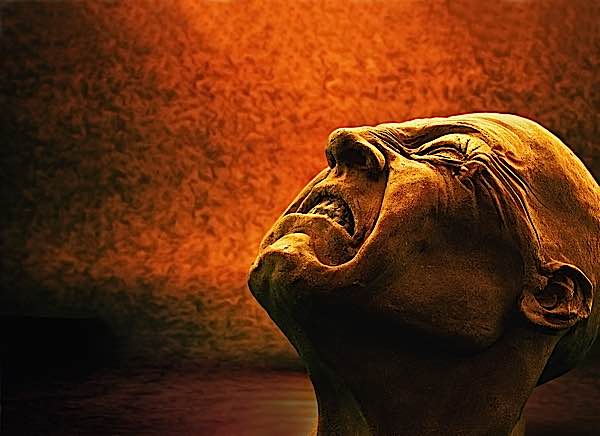
This is why we will meditate on emptiness of form. It is very beneficial, we can overcome attachment, craving, and fear, and anxiety and so on and so forth. This is why we meditate on emptiness of form first.
And then the next second skanda is the feeling, the Avalokiteshvara said, “Feeling is emptiness; emptiness is also feeling.” So now, similarly we are, as human beings, living beings, here we have a feeling. We have usually three types of feelings: happy feeling, unhappy feeling, and neutral feelings.
So the feelings go up and down and change. One day you’re happy, next you’re unhappy, and then this week you’re happy, next week you’re unhappy, or sometimes feeling changes within the day or within hours.
And then sometimes you neither feel happy nor feel sad, and you feel a kind of neutral feelings, or perhaps dull feelings, and gray kind of feeling, and also slowly, slowly kind of a depressing feeling. And that’s why people get depressions, and then very, very difficult. And once you’re going into depression, it can be very difficult. And then you have to take drugs and so forth, then side effects and so forth.
So there’s different kind of feelings, and the feelings are also cause of defilements, and some feelings are cause of grasping and excitement, whatever, and unbalanced, goes up too fast or goes down too fast, whatever, no equilibrium, no equanimity. So that’s why we meditate on feeling first, see what is feeling, and then how does the feeling exist? And does the feeling exist independently, permanently, or not? And you meditate and look at the unhappy feeling, and then meditate on anicca, the impermanence of feeling, and feeling changes.
So when you meditate on impermanence of feeling, then you feel, “Well, it’s not a big deal, my feelings change. Right now I feel a bit sad, alone, but I’ll be okay.
Tonight or tomorrow, I will be fine, especially if I meditate and practice mindfulness and breathing, or if I meditate on deity yoga and do practice, and so forth, I will feel better.
The Heart of the Perfection of Wisdom Sutra
(Ârya-bhagavatî-prajñâpâramitâ-hridaya-sûtra)
Thus did I hear at one time. The Bhagavan was dwelling on Mass of Vultures Mountain in Rajagriha together with a great community of monks and a great community of bodhisattvas. At that time, the Bhagavan was absorbed in the concentration on the categories of phenomena called “Profound Perception.”
Also, at that time, the bodhisattva mahasattva arya Avalokiteshvara looked upon the very practice of the profound perfection of wisdom and beheld those five aggregates also as empty of inherent nature.
Then, through the power of Buddha, the venerable Shariputra said this to the bodhisattva mahasattva arya Avalokiteshvara: “How should any son of the lineage train who wishes to practice the activity of the profound perfection of wisdom?”
He said that and the bodhisattva mahasattva arya Avalokiteshvara said this to the venerable Sharadvatiputra. “Shariputra, any son of the lineage or daughter of the lineage who wishes to practice the activity of the profound perfection of wisdom should look upon it like this, correctly and repeatedly beholding those five aggregates also as empty of inherent nature.
“Form is empty. Emptiness is form. Emptiness is not other than form; form is also not other than emptiness. In the same way, feeling, discrimination, compositional factors, and consciousness are empty.
“Shariputra, likewise, all phenomena are emptiness; without characteristic; unproduced, unceased; stainless, not without stain; not deficient, not fulfilled.
“Shariputra, therefore, in emptiness there is no form, no feeling, no discrimination, no compositional factors, no consciousness; no eye, no ear, no nose, no tongue, no body, no mind; no visual form, no sound, no odor, no taste, no object of touch, and no phenomenon. There is no eye element and so on up to and including no mind element and no mental consciousness element. There is no ignorance, no extinction of ignorance, and so on up to and including no aging and death and no extinction of aging and death. Similarly, there is no suffering, origination, cessation, and path; there is no exalted wisdom, no attainment, and also no non-attainment.
“Shariputra, therefore, because there is no attainment, bodhisattvas rely on and dwell in the perfection of wisdom, the mind without obscuration and without fear. Having completely passed beyond error, they reach the end-point of nirvana. All the buddhas who dwell in the three times also manifestly, completely awaken to unsurpassable, perfect, complete enlightenment in reliance on the perfection of wisdom.
“Therefore, the mantra of the perfection of wisdom, the mantra of great knowledge, the unsurpassed mantra, the mantra equal to the unequaled, the mantra that thoroughly pacifies all suffering, should be known as truth since it is not false. The mantra of the perfection of wisdom is declared:
TADYATHA [OM] GATE GATE PARAGATE PARASAMGATE BODHI SVAHA
“Shariputra, the bodhisattva mahasattva should train in the profound perfection of wisdom like that.”
Then the Bhagavan arose from that concentration and commended the bodhisattva mahasattva arya Avalokiteshvara saying: “Well said, well said, son of the lineage, it is like that. It is like that; one should practice the profound perfection of wisdom just as you have indicated; even the tathagatas rejoice.”
The Bhagavan having thus spoken, the venerable Sharadvatiputra, the bodhisattva mahasattva arya Avalokiteshvara, those surrounding in their entirety along with the world of gods, humans, asuras, and gandharvas were overjoyed and highly praised that spoken by the Bhagavan.
(This completes the Ârya-bhagavatî-prajñâpâramitâ-hridaya-sûtra)
About H.E. Archarya Zasep Tulku Rinpoche

Zasep Tulku Rinpoche teaching in Mongolia.
Rinpoche is popularly known for his approachable teaching style, strong humor and teachings based on a long lineage of great lamas. His own gurus included the most celebrated of Gelug teachers: His Holiness Kyabje Trijang Rinpoche, His Holiness Kyabje Ling Rinpoche, Venerable Geshe Thupten Wanggyel, His Holiness Kyabje Zong Rinpoche, Venerable Lati Rinpoche, Venerable Tara Tulku Rinpoche and Venerable Khalkha Jetsun Dampa Rinpoche.
Rinpoche is spiritual director of many temples, meditation centers and retreat centers in Australia, the United States and Canada. He was first invited to teach in Australia by Lama Thubten Yeshe in 1976.
Latest Features
Please support the "Spread the Dharma" mission as one of our heroic Dharma Supporting Members, or with a one-time donation.
Please Help Support the “Spread the Dharma” Mission!

Be a part of the noble mission as a supporting member or a patron, or a volunteer contributor of content.
The power of Dharma to help sentient beings, in part, lies in ensuring access to Buddha’s precious Dharma — the mission of Buddha Weekly. We can’t do it without you!
A non-profit association since 2007, Buddha Weekly published many feature articles, videos, and, podcasts. Please consider supporting the mission to preserve and “Spread the Dharma." Your support as either a patron or a supporting member helps defray the high costs of producing quality Dharma content. Thank you! Learn more here, or become one of our super karma heroes on Patreon.
Venerable Zasep Rinpoche
Author | Buddha Weekly
Rinpoche is spiritual head of many Dharma Centres, and teaches around the world. Originally from Kham province in Tibet (born 1948) Rinpoche has taught in the west since 1976, after he was first invited by Geshe Thubten Loden and Lama Yeshe to teach at the Chenrezig Institute in Australia. Today, he is spiritual head of the Gaden for the West centres in Canada, U.S., and Australia and also spiritual director of the the charities Gaden Relief Project (Canada) and Manlha Tus NGO (Mongolia). He is the author of three books, including his latest release in 2018 with a rare English commentary and practice instructions for Gelug Mahamudra.



